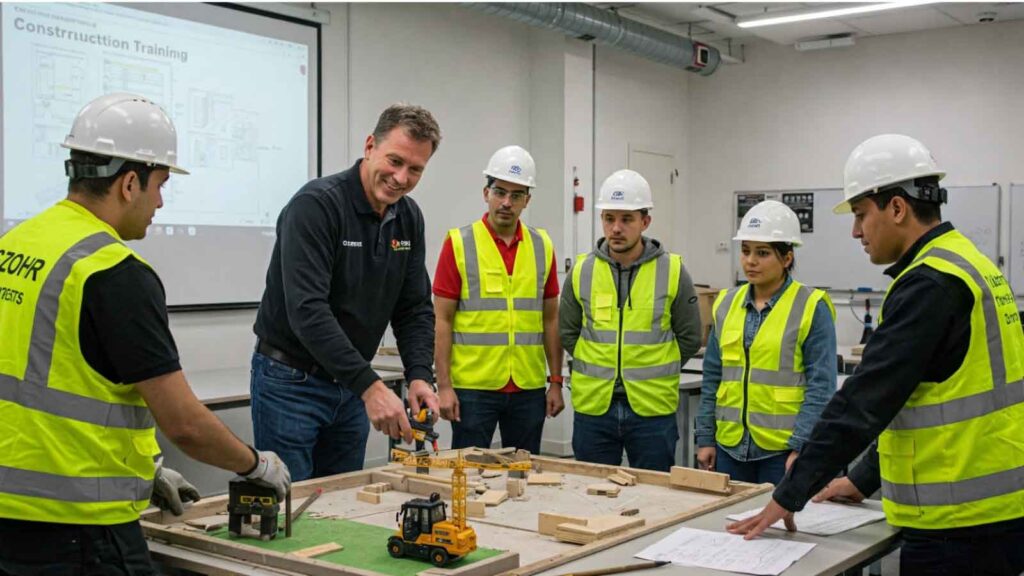A construction site bustling with activity highlights the urgent need for skilled workers across trades and management roles.
The construction industry is booming across the United States. New housing, major infrastructure projects, and commercial developments are in high demand as cities expand and investments grow.
But behind this momentum is a significant challenge: there aren’t enough skilled workers to meet the surge in projects. Many companies are struggling to fill critical roles, from tradespeople to site supervisors.
This shortage isn’t just a temporary issue; it’s a fundamental shift in the industry. As demand rises and the workforce shrinks, construction businesses are being forced to adapt quickly to stay competitive.
Why the Construction Industry Is Facing a Skilled Labor Shortage
The skilled labor shortage in construction is the result of several long-standing trends, but solving it requires more than just awareness. It takes forward-thinking executive leadership to reshape hiring strategies, build robust talent pipelines, and implement sustainable workforce solutions.
Here’s what’s driving the gap:
- Many skilled workers are retiring: The construction workforce is aging, and a large number of experienced tradespeople are reaching retirement age. As these workers leave the industry, there aren’t enough new professionals ready to step into their roles, creating a widening talent gap in leadership and essential skills.
- Fewer young people are choosing construction careers: For decades, young people have been steered toward four-year degrees over vocational trades. This has shrunk the pipeline just when it’s needed most. Innovative leaders are working to change perceptions by partnering with education providers and creating pathways that make construction careers more appealing to the next generation.
- Demand for construction projects is rising faster than the workforce: Population growth and infrastructure investments are fueling an unprecedented wave of construction. But when the labor supply can’t keep up, it’s up to company leadership to rethink how projects are staffed and delivered. Many are turning to technology and strategic workforce planning to bridge immediate gaps while building long-term resilience.
- Companies are competing harder for a limited talent pool: Because there are fewer qualified workers available, construction firms are facing tougher competition to attract and retain skilled employees. This makes it harder to staff projects efficiently and can cause delays or cost overruns if companies can’t secure enough talent.
How Construction Companies Are Adapting Right Now
To keep up with rising project demands, construction companies are already taking practical steps to address the skilled labor shortage. But these efforts don’t happen on their own, they’re being driven by executives who recognize that building a stronger workforce starts at the top. Strategic leadership is critical for turning short-term fixes into long-term success.
Expanding Training and Apprenticeship Programs
Many businesses are growing their talent by offering more training and apprenticeship opportunities, a priority often set by forward-thinking executives who know that investing in internal development pays off.
Instead of relying on outside hires, they:
- Set up internal programs: To teach hands-on skills like framing, electrical work, and equipment operation. These programs often combine classroom instruction with real-world job site experience, making it easier for new workers to build practical knowledge. Training internally also ensures that workers learn company-specific processes right from the start. While these programs require upfront investment, leadership teams recognize that building in-house expertise ultimately reduces long-term hiring costs and strengthens the company’s foundation.
- Pair experienced workers with new hires: For on-the-job mentoring. Having seasoned employees train newcomers helps transfer critical skills that aren’t easily taught in a classroom. It also builds stronger team connections and boosts worker confidence from the start.
- Create clear paths from entry-level roles to higher-skilled positions: Companies outline promotion tracks so workers can see how their careers will grow over time. This helps improve employee loyalty and reduces turnover by giving workers long-term goals within the company.
Forming Recruitment Partnerships with Schools and Organizations
Construction firms are reaching out directly to new groups of potential workers by forming partnerships with:
- High schools and vocational programs: Companies introduce students to construction careers before graduation. Many companies offer presentations, workshops, and site tours to spark interest among young people. Early exposure helps students view construction as a rewarding and stable career path.
- Military transition programs: Help veterans move into construction jobs after service. Veterans bring leadership skills, discipline, and technical abilities that fit naturally into construction roles. Companies often work with military placement organizations to quickly match veterans with job opportunities.
- Career-switcher organizations: Give people from other industries a way to join the trades. These partnerships help adults who are seeking a career change learn about construction roles they may not have previously considered. By targeting mid-career professionals, businesses tap into a motivated and often overlooked talent pool.
Offering Higher Pay and Better Benefits to Attract Workers
Attracting top-tier talent across all levels requires leaders who understand market forces. Executives are reassessing compensation structures to ensure their companies remain competitive and attractive.
Many companies are:
- Increasing base pay to match rising market rates: Higher wages help construction jobs compete with other industries that are also facing labor shortages. Offering competitive pay is often the first step to attracting serious candidates quickly.
- Offering benefits like healthcare, retirement plans, and paid time off: Providing comprehensive benefits shows that companies value workers’ long-term well-being, not just their labor. Good benefits also play a significant role in convincing workers to choose construction over other industries.
- Providing signing bonuses and reimbursement for training or certifications: Bonuses and support for gaining licenses or specialized skills make roles even more appealing. These incentives can tip the scales for candidates who are considering multiple job offers.
Introducing Technology to Reduce Manual Labor on Job Sites
Technology is becoming a tool to make construction jobs less physically demanding and more efficient.
Companies are adopting:
- Project management software to streamline planning and reduce paperwork: Digital platforms help teams organize schedules, manage budgets, and track project milestones in real time. This improves communication and reduces time lost to manual record-keeping.
- Digital measuring tools and laser scanners to speed up site work: These tools allow workers to take precise measurements quickly, reducing human error and saving hours of labor. Accurate measurements also improve the overall quality and safety of the project.
- Machinery that assists with heavy lifting or repetitive tasks: Equipment like material lifts, automated bricklayers, and powered exoskeletons helps protect workers from injury and fatigue. Making job sites safer and more efficient helps companies attract workers who might otherwise be hesitant about the physical demands of the construction industry.
The Financial Impact of the Skilled Labor Shortage on Construction Firms
The shortage of skilled construction workers has a direct effect on business finances. Companies across the industry are seeing the cost of doing business rise, making it harder to stay profitable even as project demand grows.
- Higher labor costs due to increased competition: This drives up baseline labor costs across projects, even when project budgets remain the same, tightening profit margins. In competitive markets, bidding wars for workers can further inflate costs beyond initial projections.
- Project delays lead to revenue loss: Without enough skilled workers on site, construction schedules often stretch beyond their planned timelines. Delays not only frustrate clients but also result in financial penalties, increased overhead expenses, and missed opportunities to start new projects. Each postponed deadline eats into profits and creates cash flow challenges for businesses of all sizes.
Build a Workforce Strategy That Grows With You
Navigating the skilled labor shortage doesn’t have to slow you down. At The Newport Group, we help construction businesses secure the talent they need with innovative hiring strategies, and leadership placements.
Our proven approach connects companies with skilled professionals who can drive projects forward today and build lasting success for tomorrow.
Ready to strengthen your workforce and secure your growth? Contact us today for a consultation.



